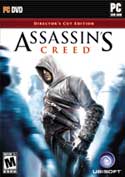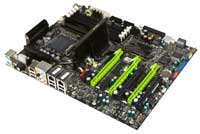
10 January 2009
NVIDIA GeForce 3D Vision

Posted by abe at 12:32 PM 1 comments
Labels:
23 December 2008
NVIDIA Preparing GT300 Next Graphics Processor Early 2009?
Specifications for the Nvidia GeForce GTX 320 graphics processor (GPU):
- NVIDIA GeForce GTX 320
- GT300 core
- 55nm technology
- 386 sq.mm die area
- 512bit GDDR5 memory controller
- GDDR5 2GB memory, doubled GTX280
- 480 stream processors
- Grating operation units are 64 the same with GTX280
- 227 GB/s memory bandwidth
- Default clock speeds of core: 830MHz, shader: 2075 MHz, memory: 3360MHz (effective)
- Pixel fill-rate 48.3G pixels/s
- Texture fill-rate 114.4Gpixels/s
- Support DirectX 11.
Specifications for the Nvdia GeForce GTX 350 graphics processor (GPU):
- NVIDIA GeForce GTX 350
- GT300 core
- 55nm technology
- 386 sq.mm die area
- 640bit GDDR5 memory controller
- GDDR5 2GB memory, doubled GTX280
- 640 stream processors
- Grating operation units are 64 the same with GTX280
- 246 GB/s memory bandwidth
- Default clock speeds of core: 900MHz, shader: 2255 MHz, memory: 3660MHz (effective)
- Pixel fill-rate 54.2G pixels/s
- Texture fill-rate 136.8Gpixels/s
- Support DirectX 11.
Posted by abe at 7:12 AM 0 comments
Labels:
NVIDIA GeForce GTX 295 Video Card Review & benchmark test
Specifications
Spec VS GTX 2xx480 Stream processors
576 MHz core clock
1242 MHz shader clock
1000 / 2000 MHz GDDR3 memory clock
1792MB total frame buffer (896MB per core)
4480-bit memory interface per core
56 total ROPs (28 per core)
160 texture units (80 per core)
Test :
Crysis Warhead :
FarCry 2
| GeForce GTX 295 | GeForce GTX 280 | GeForce GTX 260 | GeForce 9800 GX2 | Radeon HD 4870 X2 | |
|---|---|---|---|---|---|
| Manufacturing Process | 55nm TSMC | 65nm TSMC | 65nm TSMC | 65nm TSMC | 55nm TSMC |
| SPs | 480 | 240 | 216 | 256 | 1,600 |
| Core Clock | 576 MHz | 602 MHz | 576 MHz | 600 MHz | 750 MHz |
| Shader Clock | 1,242 MHz | 1,296 MHz | 1,242 MHz | 1,500 MHz | 750 MHz |
| Memory Clock | 1,998 MHz Eff. | 2,214 MHz Eff. | 1,998 MHz Eff. | 2,000 MHz Eff. | 3,600 MHz Eff. |
| Frame Buffer | 1,792 MB Tot. | 1 GB | 896 MB | 1 GB Tot. | 2 GB Tot. |
| Memory Bus Width | 448-bit x 2 | 512-bit | 448-bit | 256-bit x 2 | 256-bit x 2 |
| ROPs | 56 Tot. | 32 | 28 | 32 Tot. | 32 Tot. |
| Price | $499 MSP | ~$380 | ~$230 | N/A | ~$500 |
Posted by abe at 5:53 AM 0 comments
Labels:
NVIDIA demos Ion: 9400M for netbooks
 NVIDIA let slip details of its proposed platform for netbooks and nettops through Ubergizmo. Nicknamed Ion, the platform combines both an Intel Atom and a GeForce 9400M on a Pico-ITX mainboard. The design lets NVIDIA reduce the number of main chips for such a system from Intel’s three to two by merging the graphics, interface and memory controllers into a single chip and creates a reference design that measures just 3.9in by 2.9in even with expansion ports.
NVIDIA let slip details of its proposed platform for netbooks and nettops through Ubergizmo. Nicknamed Ion, the platform combines both an Intel Atom and a GeForce 9400M on a Pico-ITX mainboard. The design lets NVIDIA reduce the number of main chips for such a system from Intel’s three to two by merging the graphics, interface and memory controllers into a single chip and creates a reference design that measures just 3.9in by 2.9in even with expansion ports.
Posted by abe at 3:53 AM 0 comments
Labels:
 NVIDIA on Thursday was reported as having visited Taiwan computer makers as part of a campaign to pressure Intel into allowing support for the GeForce 9400M and similar chipsets with the Atom processor. The chipset designer is said to be negotiating deals that would have the local firms themselves ask Intel to remove an insistence that Atom run only on its own platform and thus let NVIDIA move in, potentially leading to much faster graphics for netbooks and nettops.
NVIDIA on Thursday was reported as having visited Taiwan computer makers as part of a campaign to pressure Intel into allowing support for the GeForce 9400M and similar chipsets with the Atom processor. The chipset designer is said to be negotiating deals that would have the local firms themselves ask Intel to remove an insistence that Atom run only on its own platform and thus let NVIDIA move in, potentially leading to much faster graphics for netbooks and nettops. We have reviewed many an Intel Atom netbook. Performance is quite standard at this point; the netbooks can handle basic multi-tasking including Web browsing and word processing and light multimedia use, such as watching streaming video or a navigating through a virtual world. But you are limited in what you can do on your netbook in terms of graphics performance and Nvidia doesn’t want it to stay that way.
We have reviewed many an Intel Atom netbook. Performance is quite standard at this point; the netbooks can handle basic multi-tasking including Web browsing and word processing and light multimedia use, such as watching streaming video or a navigating through a virtual world. But you are limited in what you can do on your netbook in terms of graphics performance and Nvidia doesn’t want it to stay that way.Tags: NVIDIA, NVIDIA Ion, NVIDIA GeForce and Intel Atom, netbooks, Acer, Asus, Toshiba, Apple
Posted by abe at 1:20 AM 0 comments
Labels:
14 December 2008
Best Values VGA Card For Games
Some Notes About Our Recommendations
A few simple guidelines to keep in mind when reading this list:
- This list is for gamers who want to get the most for their money. If you don’t play games, the cards on this list are more expensive than what you really need;
- Prices and availability change on a daily basis. We can’t offer up-to-the-minute accurate pricing info, but we can list some good cards that you probably won’t regret buying at the price ranges we suggest;
- The list is based on some of the best U.S. prices from online retailers. In other countries or at retail stores, your mileage will most certainly vary;
- These are new card prices. No used or open box cards are in the list; they might be a good deal, but it’s outside the scope of what we’re trying to do.
Good 1440x900 performance in most games
Codename: RV730
Process: 55 nm
Universal Shaders: 320
Texture Units: 32
ROPs: 8
Memory Bus: 128-bit
Core Speed MHz: 600
Memory Speed MHz: 500 (1000 effective)
DirectX / Shader Model DX 10.1 / SM 4.0
Good 1600x1200 performance in most games
Codename: RV730
Process: 55 nm
Universal Shaders: 320
Texture Units: 32
ROPs: 8
Memory Bus: 128-bit
Core Speed MHz: 750
Memory Speed MHz: 1,000 (2,000 effective)
DirectX / Shader Model DX 10.1 / SM 4.0
Codename: G92
Process: 65 nm
Universal Shaders: 96
Texture Units: 48
ROPs: 12
Memory Bus: 192- or 128-bit
Core Speed MHz: 600
Memory Speed MHz: 900 (1,800 effective)
DirectX / Shader Model DX 10 / SM 4.0
Codename: RV670
Process: 55 nm
Universal Shaders: 320
Texture Units: 16
ROPs: 16
Memory Bus: 256-bit
Core Speed MHz: 775
Memory Speed MHz: 1,125 (2,250 effective)
DirectX / Shader Model DX 10.1 / SM 4.0
Codename: G92
Process: 65 nm
Universal Shaders: 64
Texture Units: 32
ROPs: 16
Memory Bus: 256-bit
Core Speed MHz: 650
Memory Speed MHz: 900 (1,800 effective)
DirectX / Shader Model DX 10 / SM 4.0
Good 1600x1200 performance in most games; 1920x1200 in most titles with some lowered detail
Codename: RV770LE
Process: 55 nm
Universal Shaders: 640
Texture Units: 32
ROPs: 16
Memory Bus: 256-bit
Core Speed MHz: 575
Memory Speed MHz: 900 (1,800 effective)
DirectX / Shader Model DX 10.1 / SM 4.0
Codename: G92
Process: 65 nm
Universal Shaders: 112
Texture Units: 56
ROPs: 16
Memory Bus: 256-bit
Core Speed MHz: 600
Memory Speed MHz: 900 (1,800 effective)
DirectX / Shader Model DX 10 / SM 4.0
Good 1920x1200 performance in most games, some with lowered detail
Codename: RV770
Process: 55 nm
Universal Shaders: 800
Texture Units: 40
ROPs: 16
Memory Bus: 256-bit
Core Speed MHz: 625
Memory Speed MHz: 993 (1,986 effective)
DirectX / Shader Model DX 10.1 / SM 4.0
Good 1920x1200 performance
Codename: RV770
Process: 55 nm
Universal Shaders: 800
Texture Units: 40
ROPs: 16
Memory Bus: 256-bit
Core Speed MHz: 750
Memory Speed MHz: 900 (3,600 effective)
DirectX / Shader Model DX 10.1 / SM 4.0
Codename: GT200
Process: 65 nm
Universal Shaders: 192
Texture Units: 64
ROPs: 28
Memory Bus: 448-bit
Core Speed MHz: 576
Memory Speed MHz: 999 (1,998 effective)
DirectX / Shader Model DX 10 / SM 4.0
Good 1920x1200 performance
Codename: GT200
Process: 65 nm
Universal Shaders: 216
Texture Units: 72
ROPs: 28
Memory Bus: 448-bit
Core Speed MHz: 576
Memory Speed MHz: 999 (1,998 effective)
DirectX / Shader Model DX 10 / SM 4.0
Codename: RV770
Process: 55 nm
Universal Shaders: 800
Texture Units: 40
ROPs: 16
Memory Bus: 256-bit
Core Speed MHz: 750
Memory Speed MHz: 900 (3,600 effective)
DirectX / Shader Model DX 10.1 / SM 4.0
Good 1920x1200 performance in most games, 2560x1600 in most titles with some lowered detail
Codename: RV770
Process: 55 nm
Universal Shaders: 800
Texture Units: 40
ROPs: 16
Memory Bus: 256-bit
Core Speed MHz: 625
Memory Speed MHz: 993 (1986 effective)
DirectX / Shader Model DX 10.1 / SM 4.0
Good 1920x1200 performance in most games, 2560x1600 in most titles with some lowered detail
Codename: RV770
Process: 55 nm
Universal Shaders: 1,600
Texture Units: 80
ROPs: 32
Memory Bus: 256-bit
Core Speed MHz: 750
Memory Speed MHz: 900 (3,600 effective)
DirectX / Shader Model DX 10.1 / SM 4.0
Good 2560x1600 performance in most games, some with lowered detail
Codename: RV770
Process: 55 nm
Universal Shaders: 1,600
Texture Units: 80
ROPs: 32
Memory Bus: 256-bit
Core Speed MHz: 750
Memory Speed MHz: 900 (3,600 effective)
DirectX / Shader Model DX 10.1 / SM 4.0
Summary
Posted by abe at 3:44 PM 0 comments
Labels:
11 April 2008
Nvidia News
 |
Introducing the NVIDIA GeForce 9800 GX2 Beautifully designed and engineered for the most extreme graphics performance, the NVIDIA® GeForce® 9800 GX2 is an uber-powered, dual GPU graphics card for those pushing high-definition PC entertainment and gaming to the max. | In this issue:Be Part of the Excitement at NVISION 08! Boost Your AutoCAD Productivity! Assassin's Creed - Coming April 10th |
Be Part of the Excitement at NVISION 08! Join thousands of enthusiasts and professionals at NVISION 08-the first mega-event for people who are passionate about visual computing and technology. |
Posted by abe at 3:36 AM 0 comments
Labels:





















